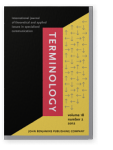Vol. 18:2 (2012) ► pp.188–225
Automatic taxonomy extraction for specialized domains using distributional semantics
This article explores a statistical, language-independent methodology for the construction of taxonomies of specialized domains from noisy corpora. In contrast to proposals that exploit linguistic information by searching for lexico-syntactic patterns that tend to express the hypernymy relation, our methodology relies entirely upon the distributional semantics of terms as captured by their lexical co-occurrence in large scale corpora. In a first stage, we analyze the syntagmatic relations of terms that serve as seeds of the taxonomy to be constructed and we obtain, thus, the first batch of hypernym candidate terms for our seed terms. In a second stage, we analyze the paradigmatic relations of the terms by inspecting which terms show a prominent frequency of co-occurrence with the terms that, as we found in the previous stage, are syntagmatically related to our seed terms — which allows us to refine the first batch of hypernym candidate terms and obtain new ones. In a third and final stage, we build a taxonomy from the obtained hypernym candidate lists, exploiting the asymmetric statistic association between terms that is characteristic of the hypernymy relation.
Cited by
Cited by 5 other publications
This list is based on CrossRef data as of 8 april 2024. Please note that it may not be complete. Sources presented here have been supplied by the respective publishers. Any errors therein should be reported to them.
